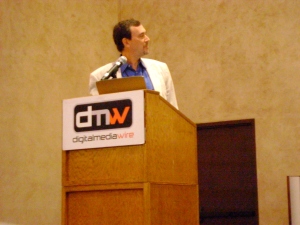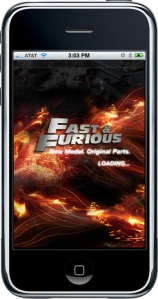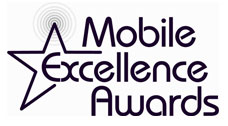It helps to start off with a solid background in publishing. Holly Schmidt, co-founder of Ravenous Romance, a publisher of erotica aimed at women and  distributed via cell phone (as well as e-books and audio books), has been in the print publishing business for 15 years for Rodale, Element Books and Quarto. Schmidt and partner Allan Penn joined literary agent Lori Perkins to start Ravenous Romance. MobilizedTV spoke to Schmidt about the ins and outs of digital publishing, online and on mobile.
distributed via cell phone (as well as e-books and audio books), has been in the print publishing business for 15 years for Rodale, Element Books and Quarto. Schmidt and partner Allan Penn joined literary agent Lori Perkins to start Ravenous Romance. MobilizedTV spoke to Schmidt about the ins and outs of digital publishing, online and on mobile.
Why did you pick the mobile phone as a platform for distribution?

We’re fascinated by digital publishing. Lori and I, having spent decades in publishing, know that e-books will be the new mass-market publishing. It made sense to publish it digitally: less waste, instant gratification and the authors make more money. So we publish both online and on mobile. If you go to our site, it’ll tell you which format to download for which device from the Blackberry or iPhone to Kindle or the Sony reader. We’re trying to give people as many options as possible.
We didn’t start this business with the intention of just targeting the cell phone market. People are reading Ravenous Romance stories and novels mainly on digital readers or the computer, and we also offer audio books. Mobile is in its early stages and people are getting comfortable with it, whereas e-books have been around for 15 years.
The conventional wisdom [with e-books] was that the most popular books would be business and history and men would be reading. It surprised the publishing business that it was women buying e-books. Fifty percent of the fiction sold on Fictionwise, an online retailer of e-books, are romance.
Is there something about the mobile platform that made a good fit for erotica aimed at women?
I think it’s portable and discreet. The fact the reader can be sitting on the train and reading a dirty story and nobody knows it has an appeal. You can stand in the line at the grocery store and read it. You’ll get commuters and business travelers. We offer short stories that you can read in 15 minutes that you can read stuck in traffic. And everyone always has their phone with them,
A number of companies have achieved significant success in selling romantic erotica in the digital space, because it’s discreet. Whether you’re reading on your PC or iPod Touch, it’s not like carrying around a paperback book. That’s why this is the biggest category in e-books.
How did you recruit writers? I understand you’ve had numerous well known writers contribute stories.
We do. Through our connections, having been in publishing for a long time, we knew a lot of writers who had followings and a good track record in print and were willing to take a leap on this new technology. We’ve been in business since August and we have 200 writers already. We get writers from Romance Writers of America–and also those in traditional print publishing who are ready to make a leap into digital publishing. What we found is we’re getting writers from other genres: a well known horror writer wrote his first erotica for us. And non-fiction writers who have always written fiction but never gotten it published. Everybody has an erotic trunk novel, as Lori likes to say. You’d be surprised how many of these writers write erotica in their spare time. We are also taking unsolicited work and we’ve found good writers that way. We’re getting submissions from agents, without agents–we’re very open there.
How do you bill? Do you have arrangements with the carriers?
People are buying directly from our site. We don’t have a deal with carriers, although we’re talking to Global Reader about getting our books up on that. Stanza is the application for the iPhone, and you can buy our books through stanza, All Romance e-books has a deal with us, and they’re on the Stanza store.
Were any of the logistics in selling content over the mobile phone daunting? Has it been worth the effort?
So far it’s been pretty easy because it hasn’t been our primary market. Our primary market is people buying on the computer or their reading devices. But we’re hearing from customers that they’re reading on their iPhone, and people are downloading to iPod. In two years, everyone will be reading on their cell phones.
How do you keep track of metrics – who’s buying what from where?
It’s tough. We know what formats they’re downloading but beyond that we don’t know anything else. You can download a PDF and read on the Blackbery, so it’s difficult to track. We’ll track it better as we go forward. The scientific way would be to make it part of the check-out proces, or we could also do a customer survey. Our customers are vocal and we hear a lot for them. The majority of them now are downloading PDFs, which leads me to believe they are reading on their computers.
How do you market Ravenous Romance?
We’ve done a number of things. We do pay-per-click, through Google and Yahoo. We do PR. We do social networking, which is really where we’re going to put more emphasis in the coming year because (a) it’s free and (b) it is the best way to build a following of people who care about our brands and products. I’m on twitter as are many of my authors. Banner ads don’t seem to do all that much. There’s so much noise on the internet, people become immune to the banner ads, so I don’t think that’s a great investment. We’re trying to do more grassroots investment. And our readers are building their own tribes and writers groups; they build their own followings that adds up. We have a Ravenous Romance Facebook group and we’re on twitter and there’s a group on Yahoo where they can talk to our authors.
How much do Ravenous Romance stories and novels cost? And what kind of revenue arrangement do you have with these writers?
Every Ravenous Rendezvous short story is $1.99, every novel is $4.99, and every audiobook is $12.99. Authors get 38 percent of each sale.
So, is it possible then to make money on mobile with the written word?
It depends how you define money. Our authors make a higher percentage than in print. [Online and mobile publishing] takes more time to build, but in a year, two years, our writers will be making serious money. There’s no shelf space limitation. Barnes & Noble can only stock so many books. As we grow the site will evolve as well.
Any thoughts of expanding into rich media?
No, I think when we expand, we’ll expand into other literary genres such as scifi, horror, young adults–other genres that lend themselves to this model. When I think of this business model, I think of pulp fiction: things you want to read but don’t necessarily want to want to line your bookshelves with. These women read a book a day, and that’s a lot of shelf space. We need to target genres similar to that. We started with romance because it’s biggest, with the most voracious readership. With young adult, we might aggressively go after the mobile market–and that genre is next.


 the movie.
the movie. entertainment.
entertainment.
 That’s true. If you type “mobile marketing” into Google, what will come up is everything from an ad agency that doesn’t have any technology all the way to Verizon and everyone in between. It’s helpful to draw ‘coarse grain segmentation’ of the marketplace. One is mobile ad networks. That’s basically doing advertising; people will sell inventory and space to take it into mobile. A second is building mobile websites, which helps people to take online properties and bring them into the mobile world. The third is around online direct marketing, or the mobile equivalent of direct marketing. That’s the category that Mozes is in. Some people call it CRM, or customer relationship management, but that means a lot of different things so I try to stay away from that term. It is about a customer community and having an engagement with them, and we do that for sure. There’s also a fourth category, which is mobile commerce or m-commerce. That’s taking your electronic storefront and bringing it into the mobile realm.
That’s true. If you type “mobile marketing” into Google, what will come up is everything from an ad agency that doesn’t have any technology all the way to Verizon and everyone in between. It’s helpful to draw ‘coarse grain segmentation’ of the marketplace. One is mobile ad networks. That’s basically doing advertising; people will sell inventory and space to take it into mobile. A second is building mobile websites, which helps people to take online properties and bring them into the mobile world. The third is around online direct marketing, or the mobile equivalent of direct marketing. That’s the category that Mozes is in. Some people call it CRM, or customer relationship management, but that means a lot of different things so I try to stay away from that term. It is about a customer community and having an engagement with them, and we do that for sure. There’s also a fourth category, which is mobile commerce or m-commerce. That’s taking your electronic storefront and bringing it into the mobile realm. episodes directly to their handheld devices.Showtime also launched its password-protected website, developed with online video platform Brightcove, allowing voters to mark their ballots online.
episodes directly to their handheld devices.Showtime also launched its password-protected website, developed with online video platform Brightcove, allowing voters to mark their ballots online. video destinations for Today, NBC Nightly News with Brian Williams, Meet the Press, Dateline, Countdown with Keith Olbermann, and The Rachel Maddow Show. In the near future, Msnbc.com will also feature video from MSNBC TV’s Morning Joe and Hardball with Chris Matthews.
video destinations for Today, NBC Nightly News with Brian Williams, Meet the Press, Dateline, Countdown with Keith Olbermann, and The Rachel Maddow Show. In the near future, Msnbc.com will also feature video from MSNBC TV’s Morning Joe and Hardball with Chris Matthews.  distributed via cell phone (as well as e-books and audio books), has been in the print publishing business for 15 years for Rodale, Element Books and Quarto. Schmidt and partner Allan Penn joined literary agent Lori Perkins to start Ravenous Romance. MobilizedTV spoke to Schmidt about the ins and outs of digital publishing, online and on mobile.
distributed via cell phone (as well as e-books and audio books), has been in the print publishing business for 15 years for Rodale, Element Books and Quarto. Schmidt and partner Allan Penn joined literary agent Lori Perkins to start Ravenous Romance. MobilizedTV spoke to Schmidt about the ins and outs of digital publishing, online and on mobile.
 stock for producers of online and mobile content. And all of you shooters creating that mobile content might be able to create a new revenue stream by licensing your footage to a stock footage company.
stock for producers of online and mobile content. And all of you shooters creating that mobile content might be able to create a new revenue stream by licensing your footage to a stock footage company.






